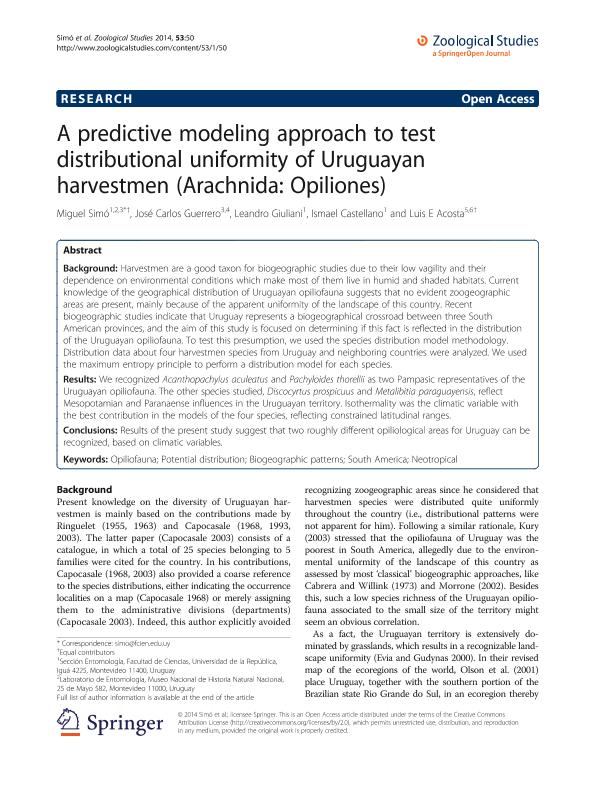Mostrar el registro sencillo del ítem
dc.contributor.author
Simó, Miguel
dc.contributor.author
Guerrero, José Carlos
dc.contributor.author
Giuliani, Leandro
dc.contributor.author
Castellano, Ismael
dc.contributor.author
Acosta, Luis Eduardo

dc.date.available
2016-11-03T21:37:18Z
dc.date.issued
2014-08
dc.identifier.citation
Simó, Miguel; Guerrero, José Carlos; Giuliani, Leandro; Castellano, Ismael; Acosta, Luis Eduardo; A predictive modeling approach to test distributional uniformity of Uruguayan harvestmen (Arachnida: Opiliones); Acad Sinica Inst Zoology; Zoological Studies; 53; 50; 8-2014; 1-13
dc.identifier.issn
1021-5506
dc.identifier.uri
http://hdl.handle.net/11336/7965
dc.description.abstract
Background: Harvestmen are a good taxon for biogeographic studies due to their low vagility and their dependence on environmental conditions which make most of them live in humid and shaded habitats. Current knowledge of the geographical distribution of Uruguayan opiliofauna suggests that no evident zoogeographic areas are present, mainly because of the apparent uniformity of the landscape of this country. Recent biogeographic studies indicate that Uruguay represents a biogeographical crossroad between three South American provinces, and the aim of this study is focused on determining if this fact is reflected in the distribution of the Uruguayan opiliofauna. To test this presumption, we used the species distribution model methodology. Distribution data about four harvestmen species from Uruguay and neighboring countries were analyzed. We used the maximum entropy principle to perform a distribution model for each species. Results: We recognized Acanthopachylus aculeatus and Pachyloides thorellii as two Pampasic representatives of the Uruguayan opiliofauna. The other species studied, Discocyrtus prospicuus and Metalibitia paraguayensis, reflect Mesopotamian and Paranaense influences in the Uruguayan territory. Isothermality was the climatic variable with the best contribution in the models of the four species, reflecting constrained latitudinal ranges. Conclusions: Results of the present study suggest that two roughly different opiliological areas for Uruguay can be recognized, based on climatic variables.
dc.format
application/pdf
dc.language.iso
eng
dc.publisher
Acad Sinica Inst Zoology

dc.rights
info:eu-repo/semantics/openAccess
dc.rights.uri
https://creativecommons.org/licenses/by-nc-sa/2.5/ar/
dc.subject
Opiliofauna
dc.subject
Potential Distribution
dc.subject
Biogeographic Patterns
dc.subject
South America
dc.subject.classification
Zoología, Ornitología, Entomología, Etología

dc.subject.classification
Ciencias Biológicas

dc.subject.classification
CIENCIAS NATURALES Y EXACTAS

dc.title
A predictive modeling approach to test distributional uniformity of Uruguayan harvestmen (Arachnida: Opiliones)
dc.type
info:eu-repo/semantics/article
dc.type
info:ar-repo/semantics/artículo
dc.type
info:eu-repo/semantics/publishedVersion
dc.date.updated
2016-11-02T18:12:09Z
dc.journal.volume
53
dc.journal.number
50
dc.journal.pagination
1-13
dc.journal.pais
China

dc.journal.ciudad
Taiwan
dc.description.fil
Fil: Simó, Miguel. Universidad de la Republica; Uruguay. Museo Nacional de Historia Natural Nacional; Uruguay
dc.description.fil
Fil: Guerrero, José Carlos. Universidad de la Republica; Uruguay
dc.description.fil
Fil: Giuliani, Leandro. Universidad de la Republica; Uruguay
dc.description.fil
Fil: Castellano, Ismael. Universidad de la Republica; Uruguay
dc.description.fil
Fil: Acosta, Luis Eduardo. Consejo Nacional de Investigaciones Cientificas y Tecnicas. Centro Cientifico Tecnologico Cordoba. Instituto de Diversidad y Ecologia Animal; Argentina. Universidad Nacional de Cordoba. Facultad de Cs.exactas Fisicas y Naturales. Catedra de Diversidad Animal I; Argentina
dc.journal.title
Zoological Studies

dc.relation.alternativeid
info:eu-repo/semantics/altIdentifier/url/http://link.springer.com/article/10.1186/s40555-014-0050-2
dc.relation.alternativeid
info:eu-repo/semantics/altIdentifier/url/https://zoologicalstudies.springeropen.com/articles/10.1186/s40555-014-0050-2
dc.relation.alternativeid
info:eu-repo/semantics/altIdentifier/doi/http://dx.doi.org/10.1186/s40555-014-0050-2
Archivos asociados
